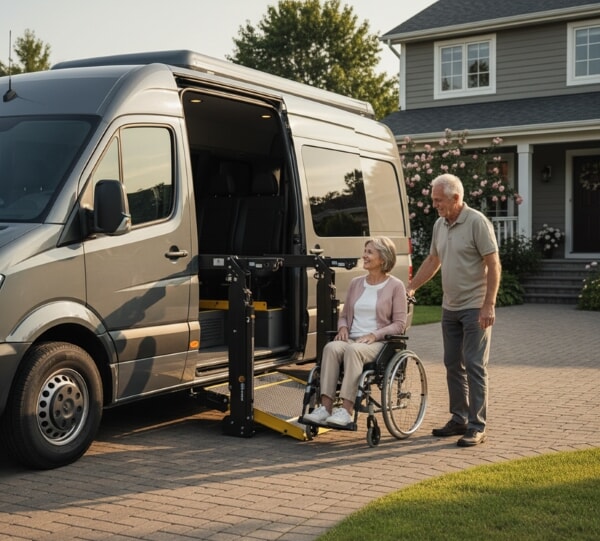How To Keep Older Adults Safe in Wheelchair-Accessible Vehicles

You may worry about how secure your parent or spouse is when you drive. If they use a wheelchair, you already understand how mobility challenges increase risk on every ride. A sudden brake, a sharp turn, or even a minor fender bender can cause serious injury, especially for older adults with fragile skin, osteoporosis, or posture problems.
A wheelchair-accessible vehicle is a car, van, or SUV modified so a person using a wheelchair can enter, travel, and sometimes drive while remaining in their chair. These vehicles often include a lowered floor, ramps or lifts, reinforced anchor points, and securement systems. These are not DIY projects. Conversions must follow Federal Motor Vehicle Safety Standards (FMVSS) to protect you or your loved one in a crash or emergency stop.
Correct securement and belt fit lowers the risk of abdominal, spinal, and head injury. They also help preserve independence so you or your loved one can continue to enjoy aging in place.
Key Safety Principles Backed by National Standards
You want to start with the correct placement inside the vehicle. Park on level ground. Center the wheelchair between anchor points. Keep clearances around footrests and wheels. Lock wheelchair brakes and power down powered chairs before attaching restraints.
Use forward-facing travel with a four-point tiedown.
The National Mobility Equipment Dealers Association (NMEDA) explains that securement straps must attach to strong structural points on the wheelchair frame, not to armrests, wheels, or trays.
All occupied wheelchairs should face forward during transit. — NMEDA.
Belt fit is critical. The National Highway Traffic Safety Administration (NHTSA) says the belts should be placed correctly. The lap belt must lie snugly across the upper thighs, not the stomach. The shoulder belt should lie snug across the shoulder and chest.
Follow wheelchair and tiedown standards. WC18 is the RESNA (Rehabilitation Engineering and Assistive Technology Society of North America) standard for wheelchair tiedowns and occupant restraints. WC19 applies to wheelchairs used as seating in motor vehicles and requires crash-tested securement points. These standards work together with FMVSS requirements for lap and shoulder restraint systems.
The U.S. Department of Transportation (DOT) requires two-part securement in ADA-regulated vans and buses, one to secure the wheelchair and a separate lap and shoulder belt for the passenger.
The University of Michigan Transportation Research Institute offers simple fit guidance.
A diagonal shoulder belt should cross the middle of the shoulder and the center of the chest, and should connect to the lap belt near the hip. — UMTRI Wheelchair Transportation Safety.
Step-By-Step: Position, Secure, Belt, Recheck
The safety features in wheelchair-accessible trucks and vans depend on this stable foundation to work effectively during transit. Most WAV injuries come from small mistakes before the vehicle even moves. You can reduce risk by taking these steps on every trip. Think of these as non-negotiables when you drive or ride in a wheelchair-accessible vehicle.
1. Position on Level Ground
Park level and set the parking brake. Center the chair between anchor points. Lock the wheelchair brakes. Power down powered chairs before attaching restraints.
2. Secure The Wheelchair to Structural Points
Attach front and rear tiedowns to the strongest structural frame points or to WC19-designated securement points. Avoid removable parts. If the chair moves in any direction when you push or pull, adjust and tighten again.
3. Face Forward
Side-facing may look convenient, but it increases injury risk in a sudden stop. Keep every occupied wheelchair facing forward.
4. Route Belts for the Pelvis and Chest
Keep the lap belt low on the bony pelvis, not on the abdomen. Keep the shoulder belt mid-shoulder and mid-chest without contacting the neck.
5. Recheck After Bumps, Turns, Or Long Rides
Road vibration loosens webbing. Check tension after rough roads and at every stop. Replace frayed webbing, damaged retractors, or loose anchor hardware.
Equipment And Standards
You want to be confident that the equipment inside the vehicle is strong enough and crash-tested. Your family should ask a few direct questions about whether the wheelchair and tiedowns meet the standards.
These details help you decide if you need upgrades, service, or professional guidance before the next trip.
- Is the wheelchair WC19-compliant?
- Are the tiedowns WTORS that meet WC18?
- Are belts FMVSS-compliant?
- Is the dealer NMEDA-QAP certified?
Training Can Improve Safety for Drivers
If you drive from your wheelchair or rely on adaptive controls, a Certified Driver Rehabilitation Specialist (CDRS) can evaluate vision, cognition, reaction time, and equipment needs and provide training inside the WAV.
Resources:
- The Association for Driver Rehabilitation Specialists (ADED) — describes CDRS certification as the highest standard of practice in the field.
- NHTSA’s Older Driver Safety — the site offers resources for older drivers and also directs families to ADED and the American Occupational Therapy Association (AOTA) to locate qualified specialists.
Simple Pre-Trip WAV Safety Checklist
You can make safety part of your routine long before you reach traffic. A simple checklist you run every time can prevent many common securing errors and protect your loved one from avoidable injury.
These are the basics your family should confirm before the vehicle moves.
- Park on level ground and set the parking brake
- Center the wheelchair and lock the brakes
- Attach four-point tiedowns to structural frame points
- Keep all occupied wheelchairs forward-facing
- Route the lap belt on the pelvis and the shoulder belt mid-shoulder/mid-chest
- Stow loose items
- Recheck tension after bumps or turns
Maintenance: Small Habits Prevent Big Problems
Inspect belts, webbing, buckles, retractors, and floor anchorages each month. Obtain service on the dealer’s schedule and after any incident. Replace worn parts immediately.
NMEDA’s Quality Assurance Program helps ensure consistent service standards for adaptive equipment.
Maintaining a Better Quality of Life
Loss of mobility is just one of the changes that can come with aging. Chronic illness, injury, or a slow decline in strength can limit your ability to move the way you always have.
Many older adults turn to wheelchairs because the chair supports their independence. It allows them to stay active and remain part of their family and community life.
Safe transportation becomes part of that independence. You cannot enjoy mobility if you are not transported safely. You need the right securement, belt fit, and equipment to prevent injury and protect posture.
It is all part of modern quality long-term care. When mobility support, transportation safety, and care planning work together, you protect not only the body but also dignity and quality of life.
Being prepared for the consequences of aging will help secure a better quality of life. Adding Long-Term Care Insurance will help ensure you have access to quality extended care, protect your income and assets, and ease the burden on those you love.
Use the tools and resources on LTC News to not only help you prepare for your personal age journey, but to help older family members find quality extended care options.
- LTC News Long-Term Care Insurance Education Center — Learn more about LTC Insurance, options, and more to help you in the process of discovering the right insurance option for you.
- LTC News Cost of Care Calculator — Find the current and projected cost of long-term care services where you or a loved one lives.
- LTC News Caregiver Directory — Search by zip code to find quality extended care options, including in-home caregivers and home health agencies, adult day care centers, assisted living, memory care, nursing homes, and more.
- LTC News partners with Amada Senior Care to provide free LTC Insurance claim support with no cost or obligation. Their trained experts can walk you through the entire process and help your loved one access their benefits quickly and correctly — File a Long-Term Care Insurance Claim.
- Find Long-Term Care Insurance specialists — Vetted specialists in long-term care solutions, licensed in your state, can provide accurate LTC Insurance quotes and recommendations.
Planning allows you to avoid a family crisis. Aging happens, and how you plan for it can make aging easier on you and those you love.


